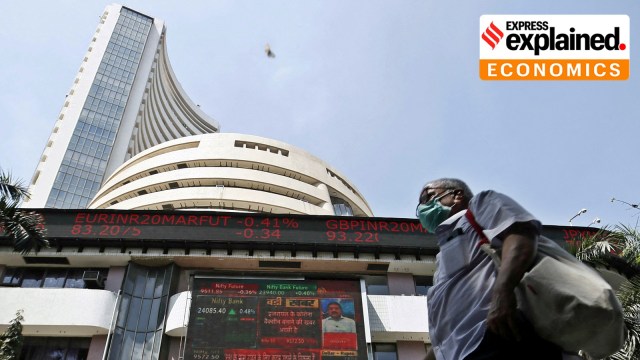Is there a bubble in small stocks? What should investors do?
How have small and mid caps done in recent months? Why are SEBI and AMFI ringing alarm bells over too much ‘froth’, price manipulation, and excessive speculation?
 A man wearing a protective mask walks past the Bombay Stock Exchange (BSE) building in Mumbai, India, March 13, 2020. (REUTERS/Francis Mascarenhas)
A man wearing a protective mask walks past the Bombay Stock Exchange (BSE) building in Mumbai, India, March 13, 2020. (REUTERS/Francis Mascarenhas)Stocks of small companies listed on the exchanges have started to show signs of becoming bubbles which, upon bursting, can badly impact investors — and regulators have sounded the warning bells.
Securities and commodity market regulator Securities and Exchange Board of India (SEBI) has said there is evidence of price manipulation in the initial public offerings (IPOs) and trading in the shares of small and medium enterprises (SMEs), and the apex body of mutual funds (MFs), the Association of Mutual Funds of India (AMFI), last month asked fund managers to act proactively to protect the interests of investors.
What is happening, and could you be impacted? We explain.
Are SME stocks being manipulated on the exchanges?
There are indeed some signs, both in the IPOs of SMEs and in the trading of SME shares, but the regulator is not in a position to take action immediately, SEBI chairperson Madhabi Puri Buch said on Monday (March 11).
“In terms of actual price manipulation (in the SME segment) both at the IPO level and the trading level, we are working to evidence that, and we do see the signs. We have the technology to do it, so we are able to see certain patterns. However, as per the regulations, the way we need to construct the entire case, we do need to take some time to do that in a robust manner,” Buch said at an AMFI event.
She said SEBI has received feedback from the market on price manipulation in the listing of SMEs. Market participants have also advised the regulator on ways to identify such cases and to deal with them. While the picture is not clear yet, market sources indicate rigging in the IPO process, and manipulation in prices after the listing.
“The reality is that these (SMEs) are relatively small entities, the market is small, the free float is small, it is relatively easy to manipulate both at the IPO level and the trading level,” Buch said.
Are many SMEs going public to raise funds?
Yes, SMEs have been flocking to the exchanges to list their shares. In 2023, there were 182 SME IPOs, which cumulatively raised more than Rs 4,600 crore, an increase of 150% over the Rs 1,800 crore raised through SME IPOs in 2022. In 2024, the first two months alone saw as many as 30 SME IPOs collectively raising more than Rs 1,000 crore.
Both the NSE and the BSE set up separate SME listing and trading platforms offering an “entrepreneur and investor friendly environment”, which enables the listing of SMEs from the unorganised sector scattered throughout India, into a regulated and organised sector. In time, when the listed SMEs achieve the required growth and size, they will be allowed to migrate to the Main Board of the exchanges, as per existing rules and regulations.
BSE SME PLATFORM VITAL STATS
| No. of companies listed on SME | 483 |
| Market cap of these listed companies | Rs 1,28,565 crore |
| Total money raised so far | Rs 6,098 crore |
| No. of companies migrated to Main Board | 183 |
| No. of companies listed as of date | 300 |
| No. of companies suspended | 31 |
| No. of companies eligible for trading | 258 |
Source: BSE
Are a lot of people investing in small-cap and mid-cap stocks?
The small and mid-cap segments have seen a surge in inflows from investors, which has raised the prices of these stocks 100-200% higher over the last year. Small and mid caps are companies with a market capitalisation of less than Rs 5,000 crore, and more than Rs 5,000 crore but less than Rs 20,000 crore respectively. Analysts have expressed concern over these valuations, which pose high risks for investors who tend to follow the herd and invest in high-priced small-cap stocks without adequate research.
Over the past six months, the Nifty Smallcap 100 index has surged by 33%, and the Nifty Midcap 100 has risen by more than 24%. This is much higher than the 14% growth seen in the benchmark Nifty 50 in the same period.
HOW THE MARKETS HAVE MOVED
1. Between Mar 1, 2023 and Feb 29, 2024
| Sensex | 22% |
| BSE Largecap | 29% |
| BSE Smallcap | 63% |
| BSE SME IPO | 141% |
2. Between Mar 1 and Mar 12, 2024
| Sensex | (-)0.10% |
| BSE Largecap | (-)0.20% |
| BSE Smallcap | (-)6% |
| BSE SME IPO | (-)11% |
Source: BSE
Between August 2023 and January 2024, small cap funds have seen net inflows of Rs 22,252.14 crore, and mid cap funds have received Rs 13,042.1 crore, according to AMFI data. Over the same period, large cap funds saw net inflows of only around Rs 1,577.04 crore.
These huge inflows contributed to the surge in small cap and mid cap stocks, with retail investors also jumping on to the bandwagon. Regulators are worried that when a correction comes, investors who invested at high valuations are bound to lose heavily, creating problems in the market.
So what have AMFI and SEBI done so far?
Regulators obviously want the money flow to small cap stocks to be moderated. On February 27, AMFI wrote to its members that asset management companies (AMCs) and fund managers should take appropriate and proactive measures to safeguard investors, including but not limited to moderating inflows, portfolio rebalancing, etc.
Steps should be taken to ensure that investors are protected from the first mover advantage of redeeming investors, AMFI said in its letter.
“In the context of froth building up in the small and mid-cap segments of the market and the continuing flows in the small and mid-cap schemes of mutual funds, trustees, in consultation with the Unitholder Protection Committee of the AMCs, shall ensure that a policy is put in place to protect the interest of all investors,” AMFI said.
Buch said SEBI could not allow bubbles to build up, and asked mutual fund trustees to formulate policies to protect the interests of investors. “Some people call it a bubble, some may call it froth. It may not be appropriate to allow that bubble to keep building because if it keeps building, then when it bursts… By definition bubbles burst, and when they burst, they impact investors adversely, which is not a good thing,” Buch said.
Asked whether the regulator would advise mutual fund houses to cap lump sum flows into any scheme, Buch said public consultation would precede any such step — “however,…trustees should have a policy in place because it sounds like a prudent thing to do…so they should look at it and formulate their own policy”.
On SME IPOs, SEBI plans to introduce more disclosures of risk factors to help investors understand that the SME segment is different from the Main Board. The regulator is working with advisors to better understand the issue and the data.
How do you know that SME stocks may be overvalued?
Analysts say that the current price-to-book (PB) value ratio of the BSE small cap index, which is 3.36, indicates that the segment is overvalued. The PB ratio is a measure of a company’s market valuation relative to its book value. Since the market value of the stock is typically higher than the book value, investors look at the PB ratio to identify investments with potential. What is a good PB ratio depends on particular businesses and the industry; however, a PB ratio of 1 or below is usually considered to be a good investment.
“For all practical purposes India is the most expensive large equity market. We believe that the analyst projections for India’s GDP and corporate earnings are too optimistic. In case the actual numbers disappoint over the next four quarters, there would be a considerable derating of the Indian market,” Amit Goel, Co-Founder and Chief Global Strategist at Pace 360, an asset management company, said.
Another analyst said the Indian market is displaying “bubble-like characteristics in many ways, and the downside potential over the next couple of years could be as high as 30-40%”. This analyst said investors should take money off the table while they can, and wait for a deep correction to buy stocks again. “The sectors to invest would depend on which sectors correct how much once the correction has completely unfolded,” the analyst said.
V K Vijayakumar, Chief Investment Strategist, Geojit Financial Services, said investors should stay away from overvalued small and mid cap stocks. “Irrational exuberance in the pockets of the broader market is unlikely to sustain. Retail investors should not be carried away by this exuberance,” he said.



- 01
- 02
- 03
- 04
- 05



































